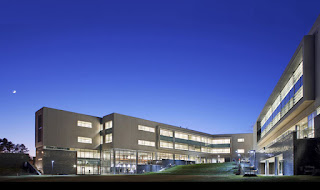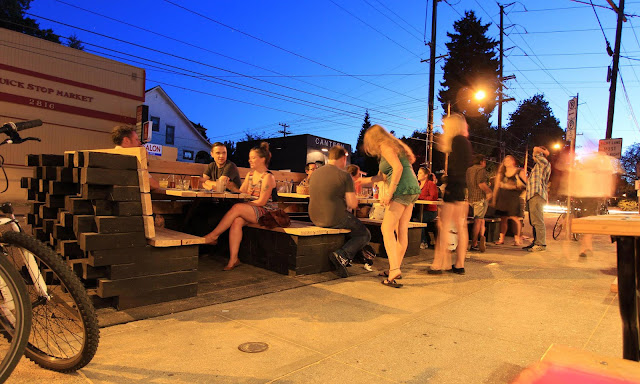Green and Gorgeous: Wake Technical College's New Green Campus
guest post by Jessica Verde
 I am passionate about everything green, especially when it comes to our built environment. It is frustrating to hear people talk about green building features as though they have to be ugly or, at the very least, uninteresting and plain. There are so many attractive ways to share this planet, and architecture is one of the most fascinating and challenging. When we surround ourselves with beauty, we feel good. Yet when we do it in a way that doesn’t hurt the planet, we feel great.
I am passionate about everything green, especially when it comes to our built environment. It is frustrating to hear people talk about green building features as though they have to be ugly or, at the very least, uninteresting and plain. There are so many attractive ways to share this planet, and architecture is one of the most fascinating and challenging. When we surround ourselves with beauty, we feel good. Yet when we do it in a way that doesn’t hurt the planet, we feel great.
There are two fundamental ways to create green buildings. The first involves existing buildings and requires replacing things like out-of-date plumbing and electrical equipment, adding insulation, replacing or enhancing windows, adding solar panels and other upgrades that improve the efficiency of the building. The second is to build a new building with all these features incorporated in the design.
Wake Technical Community College in Raleigh, North Carolina has taken this concept one huge step further. They have created an entire campus, the 121-acre Northern Wake Campus, that has gone green – and it is gorgeous. It has been certified by Leadership in Energy and Environmental Design (LEED) which means that the design and construction of every building has met their strict requirements. There are many positive aspects to this approach for building.
College campuses have, traditionally, provided the leadership of the future. Their move toward green construction is just one more example of their leading the way in efforts to reduce our negative impact on the environment. As the numbers come in and demonstrate reduced costs and an improved environment, people will be moved to act. As the results of our abuse of the environment become more apparent and destructive, universities will provide a shining example of how we can reduce our carbon footprint and improve our quality of life at the same time.
Jessica Verde is an online instructor for The College City which can be found at www.TheCollegeCity.com . Gardening is her passion, and she says she can feed her family and neighbors tomatoes, eggplant, lettuce, corn, beans and peppers from her garden.
 I am passionate about everything green, especially when it comes to our built environment. It is frustrating to hear people talk about green building features as though they have to be ugly or, at the very least, uninteresting and plain. There are so many attractive ways to share this planet, and architecture is one of the most fascinating and challenging. When we surround ourselves with beauty, we feel good. Yet when we do it in a way that doesn’t hurt the planet, we feel great.
I am passionate about everything green, especially when it comes to our built environment. It is frustrating to hear people talk about green building features as though they have to be ugly or, at the very least, uninteresting and plain. There are so many attractive ways to share this planet, and architecture is one of the most fascinating and challenging. When we surround ourselves with beauty, we feel good. Yet when we do it in a way that doesn’t hurt the planet, we feel great.There are two fundamental ways to create green buildings. The first involves existing buildings and requires replacing things like out-of-date plumbing and electrical equipment, adding insulation, replacing or enhancing windows, adding solar panels and other upgrades that improve the efficiency of the building. The second is to build a new building with all these features incorporated in the design.
Wake Technical Community College in Raleigh, North Carolina has taken this concept one huge step further. They have created an entire campus, the 121-acre Northern Wake Campus, that has gone green – and it is gorgeous. It has been certified by Leadership in Energy and Environmental Design (LEED) which means that the design and construction of every building has met their strict requirements. There are many positive aspects to this approach for building.
-
Many institutions of higher learning are public facilities. That means taxpayers are footing the bills including energy consumption. Well-constructed buildings can last for decades and longer. Even though it may be slightly more expensive to conform to LEED requirements, as energy costs continue to rise, the payoff year will be reached quickly.
-
As more campuses report success with the use of green construction, more people will be encouraged to go green themselves. As more buildings take advantage of this approach to building, these materials and techniques will become even more cost-effective as the price of green construction comes down.
-
There are many who suffer from environmentally sensitive diseases like asthma. Green buildings are designed to reduce mold and mildew as well as greenhouse gas emissions. This means that not only are the buildings healthier, the air on these campuses is better to breathe. Students should see their health improve because of the improved air quality.
-
When people attend college, they will spend several of their formative years in buildings that are environmentally friendly. They can see for themselves how comfortable and attractive these structures are. When they graduate and purchase a home, a natural question will be how can they make their homes energy efficient because of the benefits they have personally witnessed.
College campuses have, traditionally, provided the leadership of the future. Their move toward green construction is just one more example of their leading the way in efforts to reduce our negative impact on the environment. As the numbers come in and demonstrate reduced costs and an improved environment, people will be moved to act. As the results of our abuse of the environment become more apparent and destructive, universities will provide a shining example of how we can reduce our carbon footprint and improve our quality of life at the same time.
Jessica Verde is an online instructor for The College City which can be found at www.TheCollegeCity.com . Gardening is her passion, and she says she can feed her family and neighbors tomatoes, eggplant, lettuce, corn, beans and peppers from her garden.






